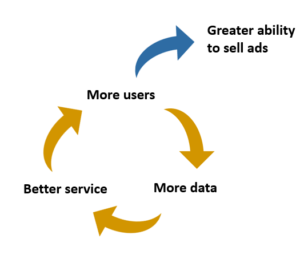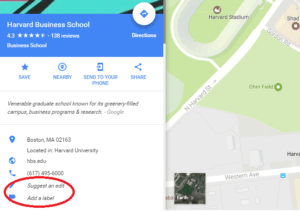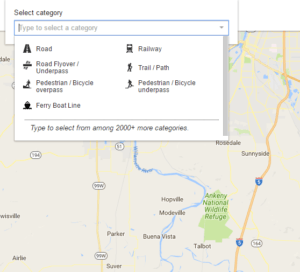Google Maps: the winner that begets winning

The forces behind how Google Maps keeps winning and helps others to win too
Every time you’re looking for a restaurant, hair dresser or interview location, Google Maps is there. Every time you’re walking around the block, calling an Uber, or planning an overseas trip, Google Maps is there. Basically, every time you leave your house/dorm/socially-minded artists’ commune, Google Maps is there, providing you instant directions to get where you want to go.
If this sounds like you, then you’re among friends – in fact, among a billion other people who regularly use Google Maps.[1] With a user base like that, it’s hard not to consider Google Maps a winner. However, have you ever considered what drives Google Maps’ continued success? How does Google Maps structure its operating and business model, and utilise digital innovations, to become and remain, a winner? The answer all starts with you because…
It’s powered by a virtuous cycle of crowd-sourced information
In today’s world of always on, always connected smartphones, Google Maps is able to access the location and speed of you and millions of other individuals in real time. Within this data lies tremendous potential.
As early as 2009, Google Maps started harnessing this information to deliver real-time traffic information. This allows Google Maps to generate more accurate travel time estimates and more efficient navigation recommendations. This geospatial tracking also presents other quirky benefits such as identifying when certain locations (e.g., restaurants) are most popular.
In addition to crowd-sourcing passively-collected data, Google Maps also asks users to actively contribute. Users can suggest edits or additions, or even draw parts of the map itself using MapMaker.[2]
‘Suggest an edit’ functionality in Google Maps
MapMaker map editing tools
All of this crowd-sourced information helps improve the Google Maps experience, creating a virtuous cycle of a better product and more users. Google Maps can then capture value from businesses who want to leverage its immense user base to deliver targeted advertising.

Google Maps’ virtuous cycle of crowd-sourcing
Of course, there’s still only so much that humans are capable of doing so…
It utilises machine learning to scale and create competitive advantage
Machine learning is one of the ultimate buzzwords in the digital space. Basically, it refers to algorithms that allow computers to improve the way they function without necessitating further human intervention. Humans provide examples and the computer figures it out from there using the observations it encounters.
Machine learning is a key component in Google Maps’ ability to cover the entire world without having human input on every piece of information. One application is using object recognition in conjunction with Street View[3] to provide automated navigational guidance on roads and intersections. It is also used to scrape information on local businesses such as opening hours and contact information, improving Google Maps’ comprehensiveness and therefore usefulness.
Things Google Maps’ machine learning algorithms identify from Street View to improve navigation [4]
The more data that’s fed into the system, the smarter and more accurate it gets, the further ahead Google Maps races from any competitors that might want to play ‘catch up’ (*ahem* Apple Maps *ahem*).
However, rather than just creating a high-functioning product, Google Maps has also embedded itself in the digital ecosystem and made itself indispensable because…
It powers and captures value from other digital winners
In its wake, Google Maps has left behind a slew of defeated competitors like the physical map and in-car navigation systems. However, it has also created a whole new generation of winners through allowing other applications to use its features via its application program interface (API).
For the vast majority of API users, the service is entirely free. However, once an API user goes over a certain usage limit, or uses Google Maps in a paid commercial endeavour, Google Maps starts charging based on usage volume.[5] With this business model, Google Maps encourages all developers to utilise it but gets to capture a chunk of the value when a program becomes popular.
As a result, Google Maps has become a core component of many other digital winners such as Uber (when it first started), TripAdvisor, and Airbnb. No doubt, it will also power many of the winners that have not yet (fully) emerged such as self-driving cars, and virtual and augmented reality – helping to increase the overall value created for society while making sure that it captures its share.
[1] http://www.businessinsider.com/google-services-with-1-billion-users-2015-10
[2] MapMaker is slated to be shut down in March 2017 and its features migrated to Google Maps
[3] A Google project whereby panoramic photos are being taken along streets around the world
[4] https://www.wired.com/2014/12/google-maps-ground-truth/
[5] https://developers.google.com/maps/





For sure one of the greatest apps I have on my phone! My only complaint with the crowd-sourced data and machine learning aspects of the app are that were it predicts journey times it uses current data for the entire leg of the journey. For example, if I’m going from Boston to NYC, the ETA is calculated using traffic along the entire route at the present. However it is a 4 hour journey and so the traffic at the halfway point will be very different when I get there compared to when I set off initially. Ideally Google Maps should better use its crowd-sourced data and machine learning to “predict” the traffic along the entire length of the journey.
Thanks for your comment, Yun!
I see what you’re saying. However, given that we can use Google Maps to predict traffic at a given time and day, I think it’s likely some predictions are used in the time estimate of your long journey. As an ex-Google engineer once said, their time estimates utilise “historical average speed data over certain time periods (sometimes just averages, sometimes at particular times of day), actual travel times from previous users, and real-time traffic information.” (source: http://www.forbes.com/sites/quora/2013/07/31/how-does-google-maps-calculate-your-eta/#7373b814655d)
Of course, Google Maps can’t predict that there’ll be a four-car pile-up on I-95 so there’s always room for improvement.
This is actually a problem some mapping apps have tried to solve. Waze tries to get to “real time” traffic by using the speed that its drivers are traveling in real time to update on a more frequent basis than google maps. Waze also uses self-reporting to do this. Googles mapping function is actually worse by the method you describe Melli. This shows that the traffic data is basically being cached and therefore even less reliable.
A unique approach to solving this problem is one that leverages a currently underutilized data source. When you sit at a red light there are often sensors under the ground to know whether a car is present. This helps traffic lights determine how to operate. For example, maybe if there are no cars it will stay red for longer. However, you can use this underlying data to pull real-time traffic patterns calculating the space in time between cars passing as the average speed of those cars and a real understanding of current traffic situations.
Google Maps really is a major winner. As someone with zero navigation skills, and very little reason to improve it (with Google Maps around) this app is everything. This summer during my internship I left the office for a nearby meeting (I used Google Maps to get there, 10 minute walk), my phone died during the meeting and it took me 25 minutes to walk back to the office! I realized how I had completely turned-off my sense of direction after using Google Maps for so long. This winter break I organized a trip to take friends from HBS to Saudi and pre-planned all our journeys weeks in advance using the traffic predictions feature, it was incredibly accurate.
Ahaha yes, I’ve had many similar encounters trying to navigate without Google Maps. Once, in Manhattan, I accidentally managed to walk myself onto the freeway (in Manhattan of all places!)
A real winner – great article!
I think the only real challenger in this field in the past years was Waze, who were acquired by Google for $1.3B. I’ve always wondered why Google, ever since the purchase, has still decided to maintain two platforms and not close one of them; functionality is almost identical nowadays! What are your thoughts?
That’s a good question Yuval. So they have been doing some integration (see: https://www.bloomberg.com/news/videos/b/134a9a0a-8924-43a6-8d81-46b4699cba9c), but it’s been quite slow. My suspicion is that 1) it’s quite difficult, 2) they don’t want to risk losing the Waze users (who are very highly engaged as A2017 points out above), and 3) the urgency is not there since the risk of a competitor acquiring Waze is off the table.
Google Maps consistently amazes me. I use it just about every single day, and it seems to be light-years ahead of the competition with regards to data, features, and users (something like 70% of iPhone users choose Google Maps over the native Apple Maps). The app creates huge amounts of value for users: they no longer have to purchase, and spend time deciphering, paper maps, nor do they need an expensive in-car GPS to drive in unfamiliar places. And users (generally) don’t have to worry about getting lost! That likely adds up to hundreds of dollars a year for the average user in both time and money saved. But the company gives the app away for free! It’s a great example of how digital business models are changing how we think about creating and capturing value.
Haha, that’s great James! Professor Lakhani couldn’t have said it better himself 😀
Meili – Great post on Google maps.
I wonder what’s next for them? They have built such a great product and are now integrating third party apps – Uber, Opentable, etc. within Google Maps. But what’s the next game changer plan for them? Rather, how can Google Maps be disrupted?
Thank you post; indeed as per your intro and the number of posts, Google Maps seems to have become a part of our daily lives that we increasingly depend upon. You did allude to some of the revenue model of this particular App but your post made me even more curious about trying to understand what are its different component. In particular, the data capture is tremendous. Its use to feed back the mapping algorithms is clear. I wonder what other ways this formidable data can be/is being captured and participates to revenues.